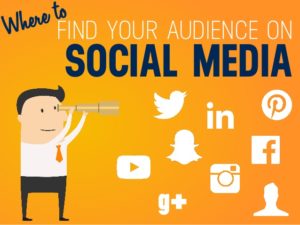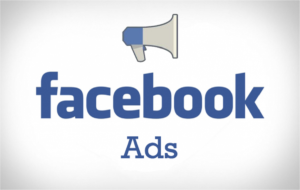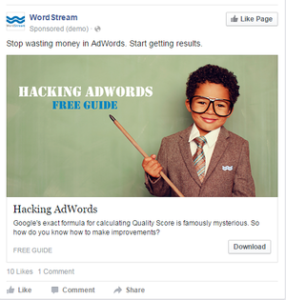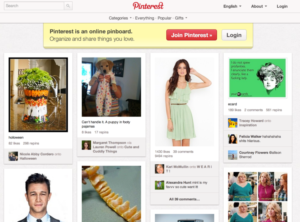 All Entries Tagged With: "social media marketing"
All Entries Tagged With: "social media marketing"
Are You Where Your Audience Is?

Seriously, understanding human behavior, or more specifically your audience’s content consumption habits, is key to creating consistent quality content that will keep your current clients, prospects and brand ambassadors engaged. We know you’ve already clearly identified your audience and we know you’re totally committed to producing really great organic content for your social posts, blogs, email campaigns, newsletters, videos, white papers, articles or other information but really identifying how your audience is consuming that information is key to your integrated marketing campaigns and efforts being effective. We don’t want you to just feel like a hamster spinning on a wheel after all! We often refer to ourselves as ‘Professional Spaghetti Throwers’ because we are constantly throwing spaghetti against the wall and quantifying what is sticking, what isn’t, what we should shelf, trash or invest more time, money and energy into. We do this within our own business and for all of our clients every day, every week, every month…it is SO important to really understand which efforts are creating a positive ROI – makes sense, right?
We often get that glazed over eye, deer in the headlights, reaction when first discussing social media campaigns with prospective clients or when giving a presentation or workshop because so many of you feel overwhelmed enough already with the amount of work it takes to run your business and the thought of adding social media with all those different platforms can make your head spin. But, it is often not as complex as most think. No, really. Oftentimes, it’s really a matter of identifying which platforms make the most sense for your business to reach your audience.
As an example…
Let’s say you’re a realtor. You’re going to want to have a professional logo and a solid web presence that clearly represents your differentiator and unique value proposition, a Facebook page, a comprehensive personal LinkedIn profile and a company profile. All of these will of course be streamlined with a clean consistent style and with tons of relevant engaging content. Are you still with us? Once you’ve mastered these basics, which we’ll refer to here as the super important foundation, (which is often the hardest part to build) the rest is fun! …Well, for us it’s fun, let’s just hope it’s not painful for you! Now you’re ready to add some more floors to that solid foundation.
Instagram: What about Instagram? We’re guessing you’ve got some pretty nice listings and/or you’ve sold some pretty nice properties to some happy clients? Take pictures when you’re working and post away! You’ll need to continue to follow a fairly consistent style or theme. Here are some great tips!
Snapchat: Okay, we know your 13 year old uses Snapchat – you must be thinking we’re crazy. Why on earth would we be suggesting you should use it for your business? Here’s an eye-opening article by Gary Vaynerchuk that’ll back up our suggestion and prove that we’re not going cuckoo! It all goes back to understanding your audience, so this platform may or may not be a good idea. If you’re selling some stylish condos in an highly sought after area that is super popular to 20 and 30 somethings, Snapchat is a great idea, but if you’re selling retirement properties…probably not so much!
Pinterest: Women are BIG decision makers and major players in the consumer real estate market so chances are Pinterest is a no brainer for the realtors out there. Here is a great article that talks specifically to that.
We didn’t touch on video in this blog but let’s just say if content is king then video content is the king’s KING! Video is consumed more and more and if done right, you can’t go wrong with video content.
We’ll be following up next week with a very beefy blog all about video content and best practices for using it in your integrated marketing strategy. Until then, happy content creating!
How To Optimize Your Facebook Ads

Ok, so if you’ve had anything to do with Facebook in the past decade (that’s right, Facebook has been around now for over 10 years!), you’ve noticed that it’s gone through some major changes. What once was a mecca for small business owners who were looking for organic reach and inexpensive advertising, has now become a frustrating place of lost content just floating around with no one paying attention to it.
Algorithm changes over the past few years has significantly decreased the organic reach of business pages. It’s gotten to the point now, where on average a business owner can expect that only 2% of the people who like their page will organically see what they’ve posted. As someone who spends a significant amount of time researching, creating and editing content to send out to the masses, that is a bummer. There’s nothing worse than knowing you have something really important to say, without an audience to say it to.
Well, once you’ve mourned the loss of your organic reach (because trust us, it’s not coming back), it’s time to buck up and make the best of it. Despite some challenges, there ARE ways you can get great reach on the social media platform at a lower cost than other outlets, and those are Facebook ads. Trying them out? Below we’re breaking down just a few tips to help you optimize your ads to ensure they’re working the best for you.
1. Spend some time researching your audience and target them. When you’re looking to target your ad don’t just go by geographic area. Take some time to do some research on some of your existing audience’s interests and likes. On Facebook you can target by general interests, things they’ve looked at on the web, and even other complimentary Facebook pages they’ve liked. Spending some time playing with the interest categories available for targeting can make a HUGE difference in your ad performance.
2. Pick the ultimate pic. Ahh the ad image. This is always the most difficult (for many people) when designing an ad. The image is the first thing people will see when scrolling through their newsfeed so you want to make sure it not only makes sense with your content, but that it’s attention grabbing as well. Find something with bright colors, interesting designs or a little bit of humor to ensure maximum results. And be sure to keep text to a minimum! While Facebook has loosened up a little on their restrictions, it will cost you more to run an ad with text in the image than one that doesn’t have any. And be sure to keep it in the 1200 x 628 wide format so it fits the space nicely.

3. Start small with the budget. A lot of times people think the more money you throw behind an ad the better. However, recent studies have shown that dramatically increasing your budget will actually cause your Cost Per Click (CPC) to go up dramatically as well! Start your budget smaller (about $5 per day) and test it out over the course of a few days to see how it’s working for you. Don’t like what’s happening? Go back and edit the image, text or both until you find the right mix. Happy with the results? Slowly increase your budget (No more that $5 per day) over time to increase the reach without increasing the CPC.
CRAFTING THE PERFECT PIN

If you have a brand that targets women (and in many cases, even men) you’ve probably heard of Pinterest. The bookmark-style brand has skyrocketed to over 100 million users who log on daily to save some of their favorite products, wedding DIY, dream home decor and fashion styles. Touting a nearly 75% purchase rate (that’s right, 75% of Pinterest users have purchased something they found on the site) it’s a digital platform that can’t be ignored.
Thinking about getting into Pinterest or have tried in the past and haven’t seen success? Well, like anything, there’s an art to pinning that can make or break your Pinterest page. Below we’re breaking down some of our favorite tips to help ensure that your pins will get seen, clicked on, and converted to sales.
1. Create a “Buyable Pin” if you can. “Buyable Pins” are something that are still growing in popularity and are still very limited to only certain commerce platforms. However, if you are one of those lucky ducks who hosts their online store on a compatible one, you can easily activate “Buyable Pins”. These allow the end user to purchase your product DIRECTLY from Pinterest, making it even easier to get that sale. Plus, word around town is Pinterest is promoting buyable pins more in users feeds than a normal pin. If you have an Etsy store, it’s not compatible with Buyable Pins yet, but you can create a “Rich Pin”. Pin directly from your store listing to feature the product price and description more prominently than a regular pin.
2. Create an eye catching image. This one may seem obvious but you’ll be shocked by how many people pin cut off or poor looking images on the site. A great idea is to create almost a cover photo by combining a great picture with some brief text of what you pin is about or where it links to. Now, you can’t add call to action text like “click here” to your pin, but a general title helps give pinners and idea of what they can expect for your pin without having to read it so the chances of them pinning to read later go up dramatically. Research has shown that vertical images with a 2:3 ratio (the recommended Pinterest size is 735 x 1102 pixels) tend to be the most eye catching and get repinned the most. Need help crafting the perfect pin image? Check out Canva where you can utilize pre-sized templates and get some ideas.
3. Keywords, keywords, keywords. You knew it was coming… You HAVE to add keywords to the description of your pins if you want to see any traction. People are not only searching for pins within the actual site, but they show up on Google as well. Take a few minutes to ensure your pin descriptions include not only keywords about what your specific pin, but about your business as well.
4. Timing is everything. This one is the big one. Research has shown that pins are the most effective about 20-40 minutes after they are pinned. Because they are shown in users’ feeds based on the time they are pinned, they have an EXTREMELY short shelf life. When you sign up for a business account, you’ll get access to your analytics. This will help you see when people are responding to your pins the most and what is getting repinned. Take some time to research and test when your users will be online and save your most important pins to go live during that time (although a good rule of thumb is about 2-4pm or 8pm-1am as popular times). However, be careful because….
5. There’s nothing worse than going overboard. It may be tempting to pin all your products to your page over the span of a few hours. We get it – You’re on a roll, you have a plan and you just want to knock it out. However, because the shelf life of pins is short, it’s recommended to spread out your pinning over days, weeks and months, to ensure there’s always something fresh in your viewer’s feeds. Also, bombarding your followers with 60-70 pins at a time is super overwhelming and may turn them off from your feed. The best rule of thumb is to plan on about 15-30 pins per day, spread out over the course of 24 hours (with your most important ones going live during your optimum engagement time). Now, it’s not always ideal to check in to Pinterest at 1am, so check out some scheduling options like Buffer to help make it easier on you.
Tags pinterest, creating pins, social media, social media marketing,digital marketing, online marketing, rhode island, online consultant, digital consultant, digital marketing expert










